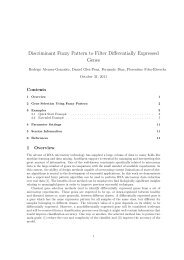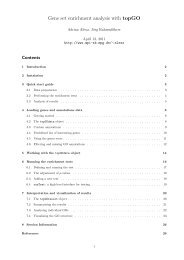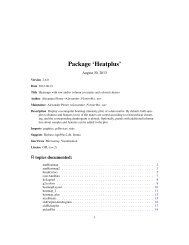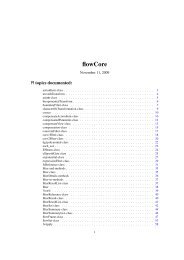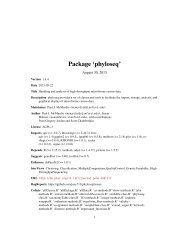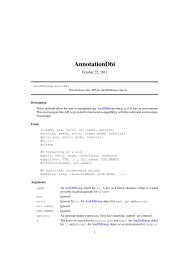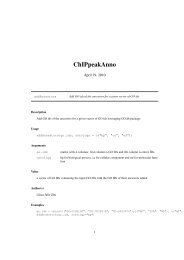GO-terms Semantic Similarity Measures
GO-terms Semantic Similarity Measures
GO-terms Semantic Similarity Measures
Create successful ePaper yourself
Turn your PDF publications into a flip-book with our unique Google optimized e-Paper software.
T A is the set of <strong>GO</strong> <strong>terms</strong> in DAG A , including term A and all of its ancestor<br />
<strong>terms</strong> in the <strong>GO</strong> graph, and E A is the set of edges connecting the <strong>GO</strong> <strong>terms</strong> in<br />
DAG A .<br />
To encode the semantics of a <strong>GO</strong> term in a measurable format to enable<br />
a quantitative comparison between two term’s semantics, we firstly define the<br />
semantic value of term A as the aggregate contribution of all <strong>terms</strong> in DAG A<br />
to the semantics of term A, <strong>terms</strong> closer to term A in DAG A contribute more<br />
to its semantics. Thus, define the contribution of a <strong>GO</strong> term t to the semantics<br />
of <strong>GO</strong> term A as the S-value of <strong>GO</strong> term t related to term A. For any of term<br />
t in DAG A = (A, T A , E A ), its S-value related to term A. S A (t) is defined as:<br />
{<br />
SA (A) = 1<br />
S A (t) = max{w e × S A (t ′ )|t ′ ∈ childrenof(t)} if t ≠ A<br />
where w e is the semantic contribution factor for edge e ∈ E A linking term t<br />
with its child term t’. We defined term A contributes to its own as one. After<br />
obtaining the S-values for all <strong>terms</strong> in DAG A , the semantic value of <strong>GO</strong> term<br />
A, SV(A), is calculated as:<br />
SV (A) = ∑<br />
t∈T A<br />
S A (t)<br />
Given two <strong>GO</strong> <strong>terms</strong> A and B, the semantic similarity between these two<br />
<strong>terms</strong>, <strong>GO</strong> A,B , is defined as:<br />
S <strong>GO</strong> (A, B) =<br />
∑<br />
t∈T A ∩T B<br />
S A (t) + S B (t)<br />
SV (A) + SV (B)<br />
where S A (t) is the S-value of <strong>GO</strong> term t related to term A and S B (t) is the<br />
S-value of <strong>GO</strong> term t related to term B.<br />
The method descriped above is proposed by Wang[Wang et al., 2007]. The<br />
Wang’s method determines the semantic similarity of two <strong>GO</strong> <strong>terms</strong> based on<br />
both the locations of these <strong>terms</strong> in the <strong>GO</strong> graph and their relations with their<br />
ancestor <strong>terms</strong>.<br />
The other four methods proposed by Resnik[Philip, 1999], Jiang[Jiang and<br />
Conrath, 1997], Lin[Lin, 1998] and Schlicker[Schlicker et al., 2006] are information<br />
content (IC) based, which depend on the frequencies of two <strong>GO</strong> <strong>terms</strong><br />
involved and that of their closest common ancestor term in a specific corpus<br />
of <strong>GO</strong> annotations. Information content is defined as frequency of each<br />
term occurs in the corpus. At present, <strong>GO</strong>SemSim supports analysis on<br />
many species. We used Bioconductor package org.At.tair.db, org.Ag.eg.db,<br />
org.Bt.eg.db, org.Cf.eg.db, org.Gg.eg.db, org.Pt.eg.db, org.Sco.eg.db, org.EcK12.eg.db,<br />
org.EcSakai.eg.db, org.Dm.eg.db, org.Hs.eg.db, org.Pf.plasmo.db, org.Mm.eg.db,<br />
org.Ss.eg.db, org.Rn.eg.db, org.Mmu.eg.db, org.Ce.eg.db, org.Xl.eg.db, org.Sc.sgd.db<br />
and org.Dr.eg.db to calculate the information content of Arabidopsis, Anopheles,<br />
Bovine, Canine, Chicken, Chimp, Coelicolor, E coli strain K12 and strain<br />
Sakai, Fly, Human, Malaria, Mouse, Pig, Rat, Rhesus, Worm, Xenopus, Yeast<br />
2



